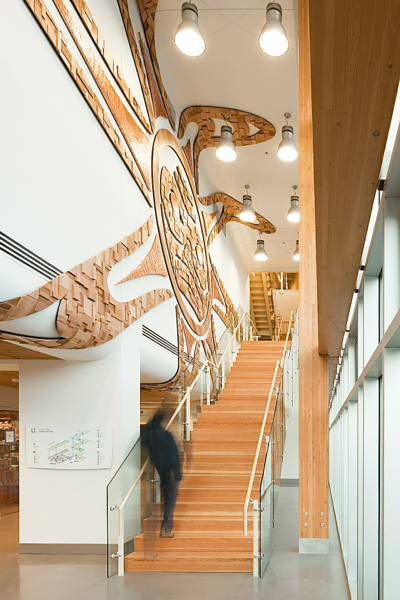Editor’s note: This story is part of an arms length collaboration with Indigenous Tourism BC. It was not reviewed or edited by our partners in travel before publication.
— By Kim Gray
Some of the most meaningful souvenirs I’ve collected as a traveller in Canada have come from First Nations artists.
A small chunk of caribou antler carved into a face with gemstone eyes. A beaded business-card pouch made from sweet-smelling smoked moose hide. An argillite bear pendant created by Haida Gwaii carver Amy Edgars.
So it’s with great interest that I’ve recently learned of an initiative called Authentic Indigenous — a program designed to give those with an interest in First Nations culture a direct line to the artists themselves and to the legitimate outlets who front them.
If you ask Brenda Baptiste, interim CEO of Aboriginal Tourism BC (which helped launch Authentic Indigenous) she’ll tell you that throughout history First Nations artists have been systematically exploited.
“Many have not been fairly compensated. Some have had their designs stolen and mass produced overseas. Overall, they’ve had very little control,” Baptiste tells me.
“Art is how we articulate our history. It’s our language and our story. Having control over our art is our highest form of self-determination.”

Pulling Together Under the Salish Sun / Shain Jackson
Internationally acclaimed Coast Salish artist and program founder Shain Jackson (see his work above) has overseen the initiative since it launched in 2014.
The owner of Spirit Works Limited says the program — which has a mandate of “speaking truth, protecting cultures and providing for people” — has vetted over 200 members for Authentic Indigenous certification to date.
Jackson says his interest in the initiative comes naturally given that decades ago his grandmother Mary Jane Jackson — a member of the Sechelt Nation — used to make cedar-root baskets and sell them for a song to support her family.
“Her story speaks to everything the program is about. This woman would get up with the sun and head to the mountains to dig roots with a stick. She would never stop. She’d split the roots with her thumb nails. I can still see her hands — beaten, bloodied and bruised,” says Jackson, who calls his late “Granny” his source of artistic inspiration.
He says she’d sit outside the local general store, weaving “incredible” baskets and selling them for a sack of flour to help feed the 10 to 15 children she sometimes watched over.
“Today, similar baskets, depending on the artist, could sell from anywhere between $800 and $6,000,” says Jackson. “Larger more elaborate ones, a papoose for example, can sell for up to $10,000.”

Sechelt artist Mary Jane Jackson / Photo courtesy Shain Jackson
In a nutshell, Authentic Indigenous certification breaks down like this:
—Tier 1: When a First Nations artist, or an artist with an indigenous company, designs, produces, and distributes a piece of artwork.
—Tier 2: When an indigenous art product is designed by an indigenous person and distributed by an indigenous person or business, but made by others outside the indigenous community.
—Tier 3: These products bear the artwork of an indigenous artist who’s been fairly compensated for their work and has also approved the final design. The producer and/or distributor need not be indigenous.
Recently, my brother gave me a striking hand-pulled silkscreen print for my birthday created by Tsimphian/Norweigan artist Bill Helin. The piece, “Journey of the Ravensong,” is the lead art for this post.
Turns out my mom, who grew up on the Northwest Coast, went to school with Helin’s mom (small world!). It also turns out that Helin is part of the Authentic Indigenous program.
This initiative, Helin tells me, is important and it will be successful “if it stays simple and focused on its original spirit and intention. It needs to remain grounded in the artist as it grows.” He also hopes further measures will be taken to educate indigenous artists about how to become successful entrepreneurs.
“And you know what I’d really like to see? A massive annual indoor art show in a major Canadian city, like Vancouver, featuring indigenous artists and marketed through some of our country’s largest stakeholders. Something like this would have a powerful impact on the lives of indigenous artists.”
It makes sense that Authentic Indigenous encourages direct contact between artists and those who appreciate their work. When we speak in person, it makes the exchange richer for everyone involved.
Our common humanity becomes part of the equation.
Case in point? During research for this story, I spoke with program member Joni Olsen, a textile artist with the family-run business Salish Fusion Knitwear.
Turns out her mom, Sylvia Olsen, is the author of Yetsa’s Sweater—a children’s storybook (and one my kids read when they were little) based on the culture of Cowichan sweaters (which my brother and I grew up wearing.)
You can bet that when I travel to Vancouver Island, I’m going to track Olsen down. I’m dying to know more about this unique tradition.
Meanwhile, check out this fine-looking toque by Salish Fushion Knitwear. I don’t know about you, but my order is in.

Photo courtesy Salish Fusion Knitwear

Jack Heinrich commented:
A magnificent story toque and canoe…..keep them coming
Jack Whyte commented:
One of my most memorable visits to the toque and canoe site. The mural on the staircase is one of the most breathtaking examples of indigenous art I’ve ever seen.
toque & canoe commented:
Thanks Jack. Lovely to see you’ve been visiting! Hope to see you on our pages some time soon. T&C
Marilyn Campbell commented:
Thank you for this enlightening article. I am a proud owner of Mary Jackson’s baskets. One in particular a small covered one, she gave me at Christmas years ago, it was still green and perfect in every dimension. I would like to have a value placed on my cherished collection. We had a retail store in Sechelt, BC, and Mary with son Lawrence were regular customers.